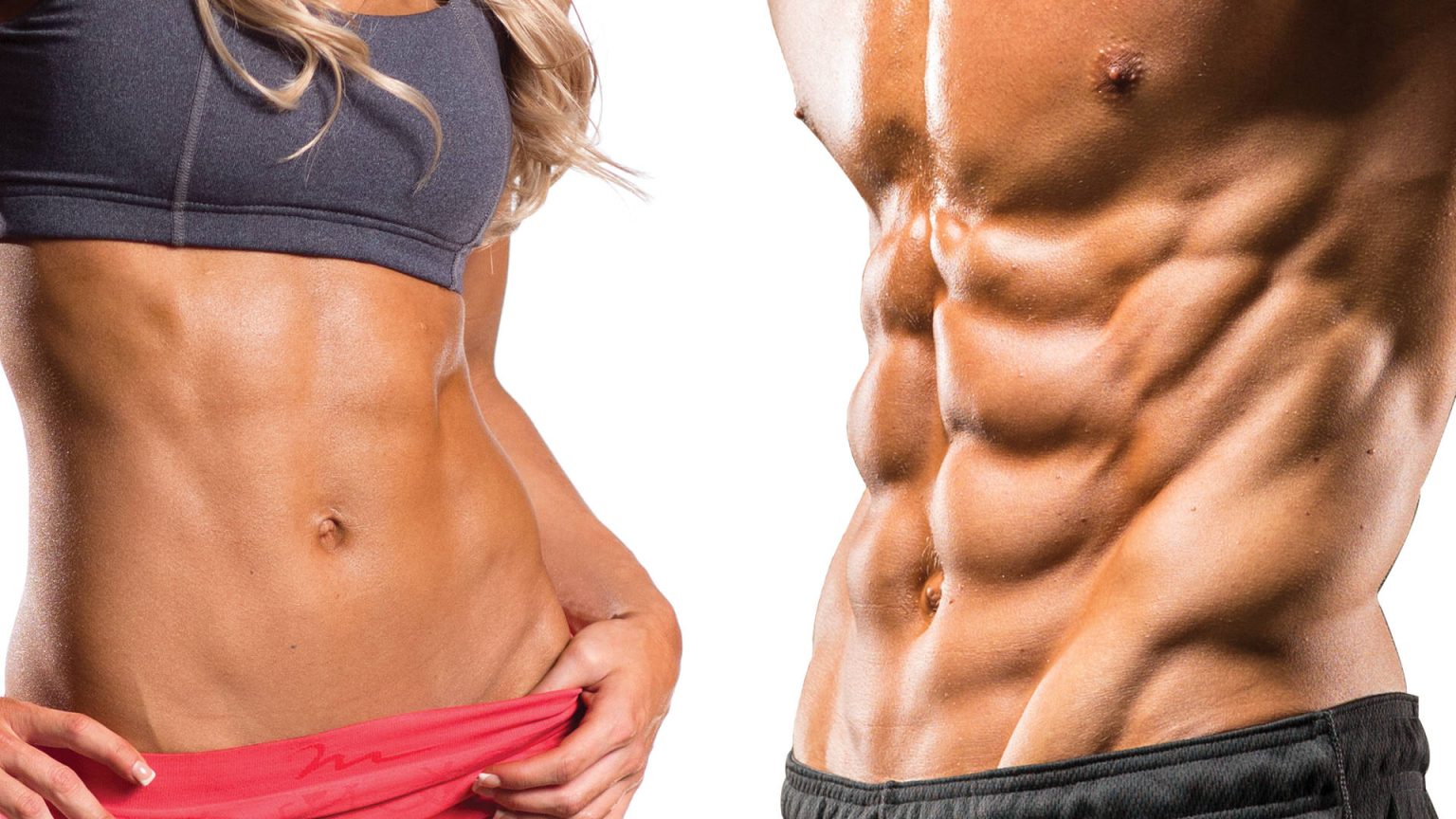How to Get a Six-Pack Fast?
Developing a six-pack requires a combination of proper diet, targeted exercises, and consistent effort. While it’s not possible to achieve visible results overnight, there are steps you can take to expedite the process and maximize your chances of getting a six-pack faster.
- Maintain a Calorie Deficit: To reveal your abdominal muscles, it’s important to reduce your overall body fat percentage. This can be achieved by consuming fewer calories than your body needs, creating a calorie deficit. Focus on eating a balanced diet with lean proteins, fruits, vegetables, and whole grains while reducing your intake of processed foods, sugary drinks, and excessive fats.
- Engage in High-Intensity Interval Training (HIIT): Incorporate HIIT workouts into your fitness routine to maximize fat burning and increase overall fitness. These workouts involve short bursts of intense exercises followed by periods of active recovery. HIIT not only helps burn calories during the workout but also boosts your metabolism, leading to fat loss even after you finish exercising.
- Prioritize Abdominal Exercises: To strengthen and define your abdominal muscles, incorporate specific exercises that target the core. Plank variations, crunches, bicycle crunches, Russian twists, and leg raises are effective exercises for developing a six-pack. Perform these exercises with proper form and gradually increase the intensity and repetitions over time.
- Include Resistance Training: Incorporate strength training exercises into your routine to build muscle mass and increase your metabolic rate. More muscle mass helps burn calories even at rest and contributes to a toned appearance. Include exercises like squats, deadlifts, lunges, and push-ups to work multiple muscle groups simultaneously.
- Stay Consistent and Progress Gradually: Getting a six-pack takes time and dedication. Consistency is key to achieving your goals. Aim to exercise regularly, at least 3-4 times a week, and gradually increase the intensity and duration of your workouts. Additionally, track your progress, adjust your routine as needed, and stay motivated by setting achievable short-term goals.
- Get Sufficient Rest and Recovery: Allow your body ample time to recover between workouts. Rest and sleep are crucial for muscle repair and growth. Aim for 7-9 hours of quality sleep each night to support your fitness goals and overall well-being.
- Stay Hydrated and Watch Your Alcohol Intake: Proper hydration is important for overall health and aids in digestion, metabolism, and fat loss. Drink an adequate amount of water throughout the day. Additionally, limit your alcohol intake, as excessive alcohol consumption can hinder your progress by adding empty calories and negatively impacting your metabolism.
Remember, achieving a six-pack requires a holistic approach that combines proper nutrition, regular exercise, consistency, and patience. Embrace a healthy and sustainable lifestyle rather than focusing solely on fast results, as long-term habits will help you maintain your progress and overall well-being.
Best Exercises to Get a Six-Pack
- Plank: The plank is an excellent exercise for engaging the entire core, including the rectus abdominis, transverse abdominis, and obliques. Start by getting into a push-up position, then lower your forearms to the ground. Keep your body in a straight line from head to toe and hold this position for as long as you can while maintaining proper form.
- Bicycle Crunches: Bicycle crunches target the rectus abdominis and obliques. Lie flat on the ground with your lower back pressed into the floor. Place your hands behind your head and bring your knees toward your chest. As you lift your upper body, bring your left elbow to your right knee while straightening your left leg. Alternate sides in a cycling motion.
- Mountain Climbers: Mountain climbers engage the core, as well as other muscles like the shoulders and legs. Start in a high plank position, with your hands directly under your shoulders. Bring one knee toward your chest, then quickly switch and bring the opposite knee forward. Continue alternating legs in a running motion while keeping your core engaged.
- Russian Twists: Russian twists target the obliques and help improve rotational strength. Sit on the ground with your knees bent and feet lifted off the floor. Lean back slightly, keeping your back straight. Hold your hands together in front of your chest and twist your torso to the right, then to the left, touching the ground on each side.
- Hanging Leg Raises: Hanging leg raises work the lower abs and hip flexors. Hang from a pull-up bar with your arms fully extended. Engage your core and lift your legs straight up until they are parallel to the floor. Slowly lower them back down and repeat.
- Reverse Crunches: Reverse crunches target the lower abs. Lie on your back with your legs bent and feet flat on the floor. Place your hands beside your hips or underneath your glutes for support. Lift your legs, bending your knees, and bring them toward your chest. Slowly lower them back to the starting position without letting your feet touch the floor.
- Swiss Ball Rollouts: Swiss ball rollouts engage the entire core, especially the deep stabilizing muscles. Start in a kneeling position with a Swiss ball in front of you. Place your forearms on the ball, keeping your back straight. Roll the ball forward, extending your arms and allowing your body to stretch out. Use your core to pull the ball back toward your knees.
Remember to combine these exercises with a well-rounded fitness routine that includes cardiovascular exercise, strength training, and a healthy diet. Consistency and progressive overload are key to developing a six-pack, so gradually increase the intensity, repetitions, or duration of these exercises as you get stronger.
What to Eat to Gain Abs?
To gain visible abs, it’s important to focus not only on exercise but also on your diet. Here are some dietary recommendations to support your goal of getting abs:
- Calorie deficit: To reveal your abs, you need to reduce your body fat percentage. This is achieved by creating a calorie deficit, which means consuming fewer calories than your body burns. Calculate your daily calorie needs and aim for a moderate calorie deficit, typically around 500-1000 calories per day.
- High protein intake: Protein is essential for building and maintaining muscle mass, which helps define your abs. Include lean sources of protein in your diet such as chicken breast, turkey, fish, tofu, Greek yogurt, eggs, and protein supplements if needed. Aim for about 0.8-1 gram of protein per pound of body weight.
- Complex carbohydrates: Choose complex carbohydrates over refined ones to provide sustained energy and support your workouts. Opt for whole grains like brown rice, quinoa, oats, and whole wheat bread. These carbohydrates also provide fiber, which aids digestion and helps keep you feeling full.
- Healthy fats: Include healthy fats in your diet as they are essential for hormone production and overall health. Focus on sources such as avocados, nuts and seeds, olive oil, fatty fish like salmon, and natural nut butters. Moderation is key as fats are calorie-dense.
- Vegetables and fruits: Load up on vegetables and fruits as they provide essential vitamins, minerals, and fiber. They are low in calories and help keep you full. Include a variety of colorful options to ensure a wide range of nutrients.
- Stay hydrated: Drink plenty of water throughout the day to support digestion, maintain energy levels, and stay hydrated during workouts. Water also helps prevent bloating and promotes overall health.
- Limit processed foods and added sugars: Minimize your intake of processed foods, sugary drinks, and snacks. These are often high in calories, unhealthy fats, and added sugars, which can hinder your progress in achieving visible abs.
Remember, achieving visible abs is a combination of reducing body fat through a balanced diet and engaging in regular exercise that targets the core muscles. It’s important to consult with a healthcare professional or registered dietitian for personalized advice based on your specific needs and goals.
How Long Does it Take to Get a Six-Pack?
The time it takes to get a six-pack varies from person to person and depends on various factors, including your current body fat percentage, genetics, diet, exercise routine, and overall lifestyle. While it’s difficult to provide an exact timeline, here are some general considerations:
- Body fat percentage: The visibility of your abs is primarily determined by your body fat percentage. To have well-defined abs, men typically need to lower their body fat percentage to around 10-12% or lower, while women generally aim for 18-20% or lower. The lower your body fat percentage, the more visible your abdominal muscles become.
- Consistency and dedication: Achieving a six-pack requires consistency in following a healthy diet and exercising regularly. It’s important to maintain a calorie deficit and stick to a well-rounded fitness routine that includes both cardiovascular exercise to burn calories and strength training exercises to build and tone your abdominal muscles.
- Timeframe: The time it takes to lower your body fat percentage and develop visible abs can range from a few weeks to several months or more. It depends on your starting point, your commitment to a healthy lifestyle, and your body’s response to diet and exercise.
- Individual differences: Everyone’s body is unique, and some individuals may naturally have a higher propensity to develop visible abs while others may find it more challenging. Genetics play a role in determining how your abdominal muscles are structured and how they appear.
- Overall health and well-being: It’s important to prioritize overall health and well-being rather than focusing solely on achieving a six-pack. Maintain a balanced approach by focusing on your overall fitness, strength, flexibility, and cardiovascular health. Remember that abs alone do not necessarily indicate overall fitness.
It’s crucial to set realistic expectations and be patient with your progress. It’s not just about achieving a six-pack but also developing sustainable habits that promote long-term health and well-being. Consult with a fitness professional or a registered dietitian for personalized guidance and support on your journey to achieving visible abs.



